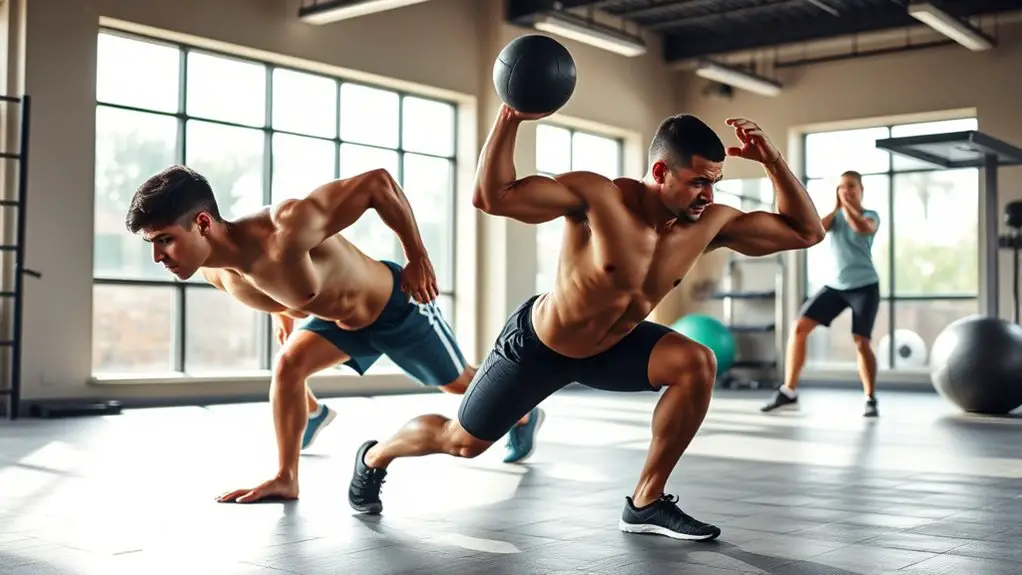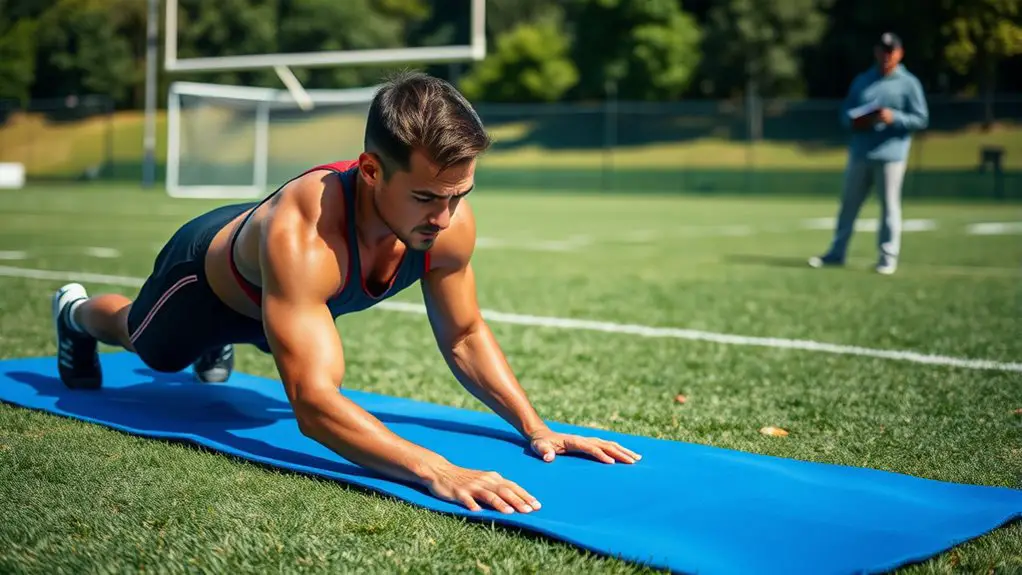To build a bulletproof core for any sport, you need to focus on functional exercises that engage all core muscles, like planks, Russian twists, and medicine ball slams. Incorporate stability training and flexibility work to enhance balance and coordinate movements. Remember to use sport-specific drills that mimic competition and avoid overtraining. All these aspects will help boost your performance and reduce injury risk. Keep exploring to discover how to create a tailored core workout plan for your needs.
Understanding the Importance of Core Strength in Sports
Core strength is the foundation of athletic performance, acting as the bridge between your upper and lower body. When you tap into core strength benefits, you're not just boosting your stability; you're revealing the freedom to move with agility and power. Many athletes fall prey to core training myths, thinking that endless crunches alone will do the trick. In reality, building a bulletproof core requires a blend of exercises that engage all areas, including balance and rotational strength. By strengthening your core, you enhance your overall performance and reduce the risk of injury, allowing you to push your limits in any sport. Embrace the journey of core training, and you'll discover how it empowers your movements, giving you the freedom to express your athleticism fully. Remember, it's about quality over quantity; focus on functional movements that align with your sport to truly harness the strength within. Additionally, a strong core reduces injury risk by supporting the spine during exertion.
Key Muscles That Make Up the Core
To truly enhance your core strength, it's important to understand the key muscles that make it up. Your core isn't just about your abs; it's a complex network that includes the rectus abdominis, obliques, transverse abdominis, and the muscles in your lower back and pelvis. These muscles work together to maintain pelvic alignment and provide stability during movement.
When these muscles engage in muscle synergy, they create a solid foundation for athletic performance, allowing for explosive movements, balance, and overall agility. Strengthening these core components helps you move freely and confidently, reducing the risk of injury. Additionally, incorporating flexibility and mobility work into your routine can enhance joint function and decrease injury risk.
Essential Core Exercises for Athletes
While you might think of crunches as the go-to core exercise, a well-rounded core workout for athletes requires a variety of movements targeting different muscle groups. To truly build a bulletproof core, you'll want to incorporate exercises that challenge your stability and strength. Here are some essential core exercises to include in your routine:
A strong core goes beyond crunches; it demands diverse movements for optimal stability and strength.
- Plank variations (side planks, forearm planks)
- Russian twists for rotational movements
- Bicycle crunches for dynamic engagement
- Medicine ball slams to build power
- Dead bugs for coordination and stability
These exercises not only strengthen the core but also enhance your overall athletic performance. By mixing in plank variations and incorporating rotational movements, you'll improve your balance, agility, and endurance. Additionally, mobility training is crucial for athletes as it supports your core stability and reduces the risk of injury. Embrace this journey to a stronger core, and watch your athletic performance soar!
Incorporating Stability Training Into Your Routine
Incorporating stability training into your routine can greatly enhance your performance in any sport. You'll not only improve your balance and coordination but also strengthen the muscles that support your core. Additionally, focusing on core stability and strength is essential for maximizing your athletic potential. Let's explore some key exercises you can include to reap these benefits.
Benefits of Stability Training
Stability training offers a solid foundation for enhancing your athletic performance, regardless of the sport you choose. By incorporating stability exercises into your routine, you can enjoy numerous benefits that boost your game and keep you moving freely. Here's what you'll gain:
- Improved balance enhancement for better control
- Increased core strength to support your movements
- Enhanced coordination, leading to more fluid performance
- Greater agility, allowing for quick reactions
- Effective injury prevention, keeping you on the field longer
Embracing stability training not only elevates your physical capabilities but also fosters a sense of freedom in your movements. You'll feel more confident tackling challenges and pushing your limits, all while protecting your body from potential injuries.
Key Exercises to Include
To build a bulletproof core, you'll want to include a variety of key exercises that target stability and strength. Start with planks and side planks to engage your deep core muscles. Incorporate dynamic movements like medicine ball throws or stability ball passes to enhance functional strength. For sport-specific training, consider exercises like single-leg deadlifts or rotational cable chops, which mimic the movements you'll encounter in your sport. Don't forget to add balance work, such as standing on one leg or using a Bosu ball, to improve your stability. These exercises will not only fortify your core but also provide you the freedom to move powerfully and efficiently on the field or court. Embrace the challenge and enjoy your journey!
The Role of Flexibility in Core Strength
While many athletes focus solely on strength training to build a powerful core, flexibility plays an equally essential role in overall core strength. A flexible core allows for greater range of motion, which enhances performance and reduces the risk of injury. Incorporating dynamic stretching and mobility drills into your routine can help you achieve this balance, giving you the freedom to move fluidly and efficiently.
Additionally, prioritizing mobility training can prevent injuries through effective mobility training, allowing athletes to enjoy their sport without the fear of limitations.
Here are some key benefits of flexibility in core strength:
- Improves range of motion for better athletic performance
- Reduces muscle tightness and risk of injury
- Enhances stability and control during movements
- Supports recovery and decreases soreness post-workout
- Boosts overall body awareness and coordination
Core Activation Techniques Before Workouts
Before you start your workout, activating your core is essential for peak performance. Effective warm-up exercises can prepare your muscles and enhance stability, helping you avoid injuries. Let's explore some core activation techniques that will set you up for success. Incorporating dynamic stretches can further improve your range of motion and readiness for physical activity.
Importance of Core Activation
Core activation is essential for optimizing performance across all sports, as it engages the muscles that stabilize your body during movement. By using effective core activation techniques, you're setting the stage for enhanced strength, balance, and coordination. Here are some core activation benefits to contemplate:
- Improves posture and alignment
- Increases power and efficiency in movements
- Reduces the risk of injury
- Enhances overall athletic performance
- Supports quicker recovery post-exercise
Incorporating core activation into your routine isn't just an option; it's a necessity. By taking the time to activate your core, you're giving yourself the freedom to move more confidently and effectively, whether you're hitting the field, court, or gym. Start prioritizing core activation now!
Effective Warm-Up Exercises
How can you guarantee your core is fully activated before diving into your workout? Start with dynamic stretching and mobility drills to wake up those muscles. Try leg swings and torso twists to increase blood flow and flexibility. Incorporate exercises like bird-dogs or glute bridges, focusing on engaging your core throughout each movement. These warm-up techniques not only prepare your body but also enhance your range of motion, giving you the freedom to move more fluidly during your workout. Remember, a well-activated core supports your entire body, improving stability and performance. So, take a few minutes to prioritize these effective warm-up exercises and feel the difference as you release your full potential in any sport.
Common Mistakes to Avoid When Training Your Core
Many athletes unknowingly make mistakes when training their core, which can hinder performance and lead to injury. It's crucial to recognize these common misconceptions and avoid ineffective exercises that don't provide the results you want. Here are some pitfalls to steer clear of:
- Relying too much on crunches and sit-ups, which can strain your back.
- Focusing solely on aesthetics instead of functional strength.
- Neglecting stability work, which is important for sports performance.
- Skipping core training altogether, thinking it's unnecessary for your sport.
- Overtraining your core without proper recovery, leading to fatigue and potential injury. Additionally, proper warm-ups help prepare muscles and reduce the risk of injury during core training.
Creating a Core Workout Plan for Your Sport
When designing a core workout plan tailored to your sport, it's essential to reflect on the specific demands and movements you'll encounter during competition. Start by identifying sport-specific exercises that mimic those movements, whether it's rotational power for tennis or stability for soccer.
Design a core workout that mirrors your sport's movements for optimal performance and injury prevention.
Incorporate core workout variations that challenge your stability and strength. Think planks, medicine ball twists, and stability ball exercises. Mix these into your routine to keep things dynamic and engaging.
Aim for balance: include both static and dynamic movements to build endurance and control. Don't forget to integrate functional drills that enhance your performance and minimize injury risk. Core strengthening exercises can significantly improve your overall effectiveness by generating more power in strikes and enhancing balance.
Finally, listen to your body and adjust your plan as needed. The freedom to adapt your workout guarantees you're always progressing and staying tuned to what works best for you. Enjoy the journey, and watch your core strength elevate your game!
Frequently Asked Questions
How Often Should I Train My Core Each Week?
Imagine feeling both anchored and free as you move, that's the power of a strong core. For ideal core training frequency, aim for two to three sessions each week. This schedule allows you to build strength without overdoing it. You'll find the right balance between hard work and recovery, giving your body the freedom to perform at its best. Embrace this workout routine, and watch your performance soar!
Can I Build Core Strength Without Gym Equipment?
Absolutely, you can build core strength without gym equipment! Bodyweight exercises like planks, mountain climbers, and Russian twists are fantastic for enhancing core stability. You don't need a gym to strengthen your core; just find a comfortable space at home or outdoors. By incorporating these exercises into your routine, you'll feel empowered and free to train anywhere, anytime. So, get started, and enjoy the journey to a stronger core!
Are There Specific Diets That Enhance Core Strength?
Yes, certain diets can enhance your core strength. Focus on quality protein sources, like lean meats, legumes, and dairy, to support muscle repair and growth. Don't forget about nutrient timing—fueling your body with the right nutrients before and after workouts can maximize your results. By prioritizing whole foods and staying hydrated, you'll not only feel great but also empower your core to perform better in whatever activities you love.
How Long Does It Take to See Core Strength Improvements?
Imagine planting a seed—your core's journey to strength isn't instant. Typically, you'll see noticeable improvements in about 4 to 8 weeks, depending on your commitment and routine. This progress timeline reflects your dedication, with each strength benchmark marking your growth. Just like a tree growing stronger with each season, your core will flourish, granting you the freedom to move with confidence and power in every aspect of your life. Keep nurturing that seed!
Is Core Training Different for Different Sports?
Yes, core training is definitely different for different sports. You've gotta focus on sport specificity to enhance your performance. For instance, a runner needs core stability for endurance, while a gymnast requires strength and flexibility. Tailoring your core workouts to your sport not only improves your performance but also helps prevent injuries. So, don't just do generic exercises; adapt your routine to fit the unique demands of your chosen sport!




